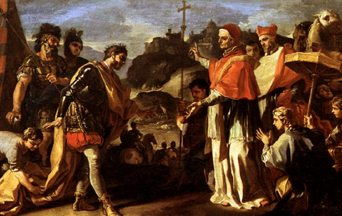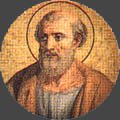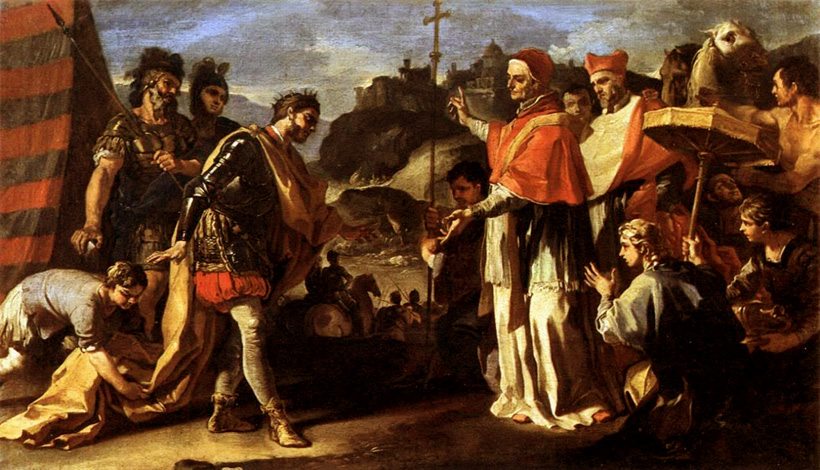
Pope Saint Leo’s pontificate, next to that of Saint Gregory I, is the most significant and important in Christian antiquity. At a time when the Church was experiencing the greatest obstacles to her progress in consequence of the hastening disintegration of the Western Empire, and while the Orient was profoundly agitated over dogmatic controversies, this great pope, with far-seeing sagacity and powerful hand, guided the destiny of the Roman and Universal Church.
Leo was descended of a noble Tuscan family, but born at Rome. His father’s name was Quintianus. Our earliest certain historical information about Leo reveals him a deacon of the Roman Church under Pope Celestine I (422-432). Even during this period he was known outside of Rome, and had some relations with Gaul, since Cassianus in 430 or 431 wrote at Leo’s suggestion his work “De Incarnatione Domini contra Nestorium” (Migne, P.L., L, 9 sqq.), prefacing it with a letter of dedication to Leo.

(reigned 432-440)
During the pontificate of Sixtus III (432-440), Leo was sent to Gaul by Emperor Valentinian III to settle a dispute and bring about a reconciliation between Aëtius, the chief military commander of the province, and the chief magistrate, Albinus. This commission is a proof of the great confidence placed in the clever and able deacon by the Imperial Court. Sixtus III died on August 19, 440, while Leo was in Gaul, and the latter was chosen his successor. Returning to Rome, Leo was consecrated on September 29 of the same year, and governed the Roman Church for the next twenty-one years.
Whilst the Eastern empire was distracted by heretical factions, the Western was harassed by barbarians. Attila the Hun, enriched with the plunder of many nations and cities, marched against Rome. The Huns, a savage nation from that part of Scythia which now lies in Muscovy, had passed the Palus Mæotis, in 276, and made their first inroads upon the coasts of the Caspian Sea, and as far as Mount Taurus in the East. Almost two hundred years after this, Attila, the most powerful and barbarous of all the kings of that nation, in 433, had marched first into the East, then subject to Theodosius the Younger, and having amassed a vast booty in Asia, returned into Pannonia, where he was already master of a large territory.
 Learn All About the Prophecies of Our Lady of Good Success About Our Times
Learn All About the Prophecies of Our Lady of Good Success About Our Times
His next expedition was directed against the western part of the empire. His army marching through Germany, drew along with it additional supplies from all the barbarous nations near which it passed, and amounted at length to the number of five hundred, Jornandes says seven hundred thousand fighting men; all stirred up by no other motive than the hope of great spoils from the plunder of the richest countries of the empire. Entering Gaul, Attila laid in ruins Tongres, Triers, and Metz. Troyes was spared by him, at the entreaty of Saint Lupus, and Saint Nicasius preserved Rheims. The barbarian had just taken Orleans by storm, when Aëtius, the Roman general, came up with him, expelled him from that city, and followed him to the plains of Mauriac or Challons, which, according to Jornandes, were extended in length one hundred miles, and seventy in breadth, and seem to have comprised the whole country, known since the sixth century under the name of Champagne. Here Attila halted, and when Aëtius with the Romans, Visigoths, and Burgundians, came up, these vast fields seemed covered with troops. In a most bloody battle, the Huns were here discomfited. Attila, enraged at this defeat, and having repaired his losses of the former year, entered Italy by Pannonia, in 453, took and burned Aquileia, and filled the whole country with blood and desolation. Some of the inhabitants, who fled from his arms into the little islands in the shallow lakes at the head of the Adriatic Gulf, here laid the foundations of the city of Venice, which we find named by Cassiodorus, fifty years after this event. Attila sacked Milan, razed Pavia, and wherever he passed laid waste whole provinces. The weak Emperor Valentinian III shut himself up in Ravenna, and the Romans, in the utmost terror, expected to see the barbarian speedily before their gates. Such was the state of affairs when Leo went to meet Attila.

In the general consternation, Saint Leo, at the request of the whole city of Rome, went to meet Attila, in hopes of mollifying his rage, and averting the danger that threatened his country. Avienus, a man of consular dignity, and Trygetius, who had been prefect of the city, were deputed to accompany him in this embassy. They found the haughty tyrant at Ambuleium, near Ravenna, where the highway passes the river Menzo. Contrary to the expectation of every one, he received the pope with great honor, gave him a favorable audience, and, through his suggestion, concluded a treaty of peace with the empire on the condition of an annual tribute. Baronius, from a writer of the eighth century, relates, that Attila saw two venerable personages, supposed to be the apostles SS. Peter and Paul, standing on the side of the pope whilst he spoke. The king immediately commanded his army to forbear all hostilities, and soon after repassed the Alps, and retired beyond the Danube into Pannonia; but on his way home was seized with a violent vomiting of blood, of which he died in 453.
Divisions among his children and princes destroyed the empire of the Huns (Jornand. Rer. Goth. c. 12. 49. Prosp. in Chron. ad an. 452.). Thus fell the most haughty and furious of all the barbarian heathen kings, styled the terror of the world, and the Scourge of God, whose instrument he was in punishing the sins of Christians. It was the glory of Saint Leo to have checked his fury and protected Rome, when it was in no condition of defense.
In 455, the friends of Aëtius (whose greatness and arrogance had given the emperor so much umbrage that he caused him to be assassinated) revenged the death of that general by the murder of Valentinian himself. His wife Eudoxia married by compulsion the tyrant Maximus, who had usurped his throne; but, not brooking these affronts, she invited Genseric, the Arian Vandal king, from Africa, to come and revenge the murder of her husband. Maximus fled; but was slain by Valentinian’s servants on the 12th of June, in the twenty-seventh day of his reign, in 455.
Three days after, Genseric arrived, and found the gates of Rome open to receive him. Saint Leo went out to meet him, and prevailed with him to restrain his troops from slaughter and burning, and to content himself with the plunder of the city. The example of Saint Leo shows, that even in the worst of times, a holy pastor is the greatest comfort and support of his flock. After the departure of the Vandals with their captives, and an immense booty, Saint Leo sent zealous Catholic priests and alms for the relief of the captives in Africa. He repaired the Basilicas, and replaced the rich plate and ornaments of the churches which had been plundered, though some part had escaped by being concealed, especially what belonged to the churches of SS. Peter and Paul, which Baronius thinks Genseric spared, and granted to them the privilege of sanctuaries, as was done at other times. This great pope, for his humility, mildness, and charity, was reverenced and beloved by emperors, princes, and all ranks of people, even infidels and barbarians.![]()
FREE e-Book: A Spanish Mystic in Quito
Leo’s chief aim was to sustain the unity of the Church. Not long after his elevation to the Chair of Peter, he saw himself compelled to combat energetically the heresies which seriously threatened church unity even in the West. Leo had ascertained through Bishop Septimus of Altinum, that in Aquileia priests, deacons, and clerics, who had been adherents of Pelagius, were admitted to communion without an explicit abjuration of their heresy. The pope sharply censured this procedure, and directed that a provincial synod should be assembled in Aquileia, at which such persons were to be required to abjure Pelagianism publicly and to subscribe to an unequivocal confession of Faith (epp. i and ii). This zealous pastor waged war even more strenuously against Manichæism, inasmuch as its adherents, who had been driven from Africa by the Vandals, had settled in Rome, and had succeeded in establishing a secret Manichæan community there. The pope ordered the faithful to point out these heretics to the priests, and in 443, together with the senators and presbyters, conducted in person an investigation, in the course of which the leaders of the community were examined. In several sermons he emphatically warned the Christians of Rome to be on their guard against this reprehensible heresy, and repeatedly charged them to give information about its followers, their dwellings, acquaintances, and rendezvous (Sermo ix, 4, xvi, 4; xxiv, 4; xxxiv, 4 sq.; xlii, 4 sq.; lxxvi, 6).
A number of Manichæans in Rome were converted and admitted to confession; others, who remained obdurate, were in obedience to imperial decrees banished from Rome by the civil magistrates. On January 30, 444, the pope sent a letter to all the bishops of Italy, to which he appended the documents containing his proceedings against the Manichæans in Rome, and warned them to be on their guard and to take action against the followers of the sect (ep. vii). On June 19, 445, Emperor Valentinian III issued, doubtless at the pope’s instigation, a stern edict in which he established seven punishments for the Manichæans (“Epist. Leonis”, ed. Ballerini, I, 626; ep. viii inter Leon. ep). Prosper of Aquitaine states in his “Chronicle” (ad an. 447; “Mon. Germ. hist. Auct. antiquissimi”, IX, I, 341 sqq.) that, in consequence of Leo’s energetic measures, the Manichæans were also driven out of the provinces, and even Oriental bishops emulated the pope’s example in regard to this sect. In Spain the heresy of Priscillianism still survived, and for some time had been attracting fresh adherents. Bishop Turibius of Astorga became cognizant of this, and by extensive journeys collected minute information about the condition of the churches and the spread of Priscillianism. He compiled the errors of the heresy, wrote a refutation of the same, and sent these documents to several African bishops. He also sent a copy to the pope, whereupon the latter sent a lengthy letter to Turibius (ep. xv) in refutation of the errors of the Priscillianists. Leo at the same time ordered that a council of bishops belonging to the neighboring provinces should be convened to institute a rigid inquiry, with the object of determining whether any of the bishops had become tainted with the poison of this heresy. Should any such be discovered, they were to be excommunicated without hesitation. The pope also addressed a similar letter to the bishops of the Spanish provinces, notifying them that a universal synod of all the chief pastors was to be summoned; if this should be found to be impossible, the bishops of Galicia at least should be assembled. These two synods were in fact held in Spain to deal with the points at issue (Hefele, “Konziliengesch.” II, 2nd ed., pp. 306 sqq.).
In Leo’s conception of his duties as supreme pastor, the maintenance of strict ecclesiastical discipline occupied a prominent place. This was particularly important at a time when the continual ravages of the barbarians were introducing disorder into all conditions of life, and the rules of morality were being seriously violated. Leo used his utmost energy in maintaining this discipline, insisted on the exact observance of the ecclesiastical precepts, and did not hesitate to rebuke when necessary. Letters (ep. xvii) relative to these and other matters were sent to the different bishops of the Western Empire-e.g., to the bishops of the Italian provinces (epp. iv, xix, clxvi, clxviii), and to those of Sicily, who had tolerated deviations from the Roman Liturgy in the administration of Baptism (ep. xvi), and concerning other matters (ep. xvii). A very important disciplinary decree was sent to bishop Rusticus of Narbonne (ep. clxvii). Owing to the dominion of the Vandals in Latin North Africa, the position of the Church there had become extremely gloomy. Leo sent the Roman priest Potentius thither to inform himself about the exact condition, and to forward a report to Rome. On receiving this Leo sent a letter of detailed instructions to the episcopate of the province about the adjustment of numerous ecclesiastical and disciplinary questions (ep. xii). Leo also sent a letter to Dioscurus of Alexandria on July 21, 445, urging him to the strict observance of the canons and discipline of the Roman Church (ep. ix). The primacy of the Roman Church was thus manifested under this pope in the most various and distinct ways. But it was especially in his interposition in the confusion of the Christological quarrels, which then so profoundly agitated Eastern Christendom, that Leo most brilliantly revealed himself the wise, learned, and energetic shepherd of the Church. From his first letter on this subject, written to Eutyches on June 1, 448 (ep. xx), to his last letter written to the new orthodox Patriarch of Alexandria, Timotheus Salophaciolus, on August 18, 460 (ep. clxxi), we cannot but admire the clear, positive, and systematic manner in which Leo, fortified by the primacy of the Holy See, took part in this difficult entanglement.
Eutyches appealed to the pope after he had been excommunicated by Flavian, Patriarch of Constantinople, on account of his Monophysite views. The pope, after investigating the disputed question, sent his sublime dogmatic letter to Flavian (ep. xxviii), concisely setting forth and confirming the doctrine of the Incarnation, and the union of the Divine and human natures in the one Person of Christ. In 449 the council, which was designated by Leo as the “Robber Synod”, was held. Flavian and other powerful prelates of the East appealed to the pope. The latter sent urgent letters to Constantinople, particularly to Emperor Theodosius II and Empress Pulcheria, urging them to convene a general council in order to restore peace to the Church. To the same end he used his influence with the Western emperor, Valentinian III, and his mother Galla Placidia, especially during their visit to Rome in 450. This general council was held in Chalcedon in 451 under Marcian, the successor of Theodosius. It solemnly accepted Leo’s dogmatical epistle to Flavian as an expression of the Catholic Faith concerning the Person of Christ. The pope confirmed the decrees of the Council after eliminating the canon, which elevated the Patriarchate of Constantinople, while diminishing the rights of the ancient Oriental patriarchs. On March 21, 453, Leo issued a circular letter confirming his dogmatic definition (ep. cxiv). Through the mediation of Bishop Julian of Cos, who was at that time the papal ambassador in Constantinople, the pope tried to protect further ecclesiastical interests in the Orient. He persuaded the new Emperor of Constantinople, Leo I, to remove the heretical and irregular patriarch, Timotheus Ailurus, from the See of Alexandria. A new and orthodox patriarch, Timotheus Salophaciolus, was chosen to fill his place, and received the congratulations of the pope in the last letter which Leo ever sent to the Orient.
Leo was no less active in the spiritual elevation of the Roman congregations, and his sermons, of which ninety-six genuine examples have been preserved, are remarkable for their profundity, clearness of diction, and elevated style. The first five of these, which were delivered on the anniversaries of his consecration, manifest his lofty conception of the dignity of his office, as well as his thorough conviction of the primacy of the Bishop of Rome, shown forth in so outspoken and decisive a manner by his whole activity as supreme pastor. Of his letters, which are of great importance for church history, 143 have come down to us: we also possess thirty which were sent to him. The so-called “Sacramentarium Leonianum” is a collection of orations and prefaces of the Mass, prepared in the second half of the sixth century.
Leo died on November 10, 461, and was buried in the vestibule of Saint Peter’s on the Vatican. In 688 Pope Sergius had his remains transferred to the basilica itself, and a special altar erected over them. They rest today in Saint Peter’s, beneath the altar specially dedicated to Saint Leo. In 1754 Benedict XIV exalted him to the dignity of Doctor of the Church (doctor ecclesiæ).
(cfr. 1913 Catholic Encyclopedia and Lives of the Saints, by Fr. Alban Butler.)
